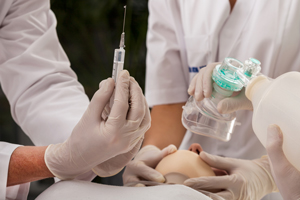What is a neck lift?
Much like other areas of our bodies, there is a way to enhance the look of your neck to make it appear less wrinkly and more youthful. What you may call a neck lift has many parts to it, each having their own definition which can get confusing when you are searching online for information about the procedure.
You have probably seen and heard the terms cervicoplasty, platysmaplasty or a lower rhytidectomy at various stages of your search. A cosmetic neck lift most commonly involves all three of these procedures.
It is rare to only conduct one of them on its own. Here’s a description of what each of them mean as well as other important information that you will need when deciding to undergo a cosmetic neck lift.
Cervicoplasty

Not to be confused with surgery on the cervix of the uterus that also carries the same name, a cervicoplasty refers to the tightening of the platysma (the muscles from the collarbone to the jaw) as well as the skin in the neck area. Wrinkles, droopiness, sagging, these are all issues that can be reduced or corrected with a cervicoplasty.
Platysmaplasty
 While a cervicoplasty focuses on tightening the platysma and the skin in the neck area, a platysmaplasty refers to the tightening of the platysma only. Cosmetically, it’s rare that a patient receives this procedure on its own. It is usually combined with a cervicoplasty as well as a lower rhytidectomy.
While a cervicoplasty focuses on tightening the platysma and the skin in the neck area, a platysmaplasty refers to the tightening of the platysma only. Cosmetically, it’s rare that a patient receives this procedure on its own. It is usually combined with a cervicoplasty as well as a lower rhytidectomy.
Lower Rhytidectomy
 Commonly referred to as a lower facelift, a lower rhitedectomy is for patients who are not ready for a full facelift but are unhappy with the sagging skin on their neck and jawline. This lifting and trimming of excess skin tightens everything under the zygoma (the check bone that sits right below your ear) usually includes a platysmaplasty as well as a cervicoplasty.
Commonly referred to as a lower facelift, a lower rhitedectomy is for patients who are not ready for a full facelift but are unhappy with the sagging skin on their neck and jawline. This lifting and trimming of excess skin tightens everything under the zygoma (the check bone that sits right below your ear) usually includes a platysmaplasty as well as a cervicoplasty.
Ideal Candidate
Before considering any kind of a neck lift the patient has to be identified as a potential candidate.
If you are unhappy with the wrinkly nature of your neck or the fact that it sags and droops, then choosing the correct type of neck surgery is very important. Patients should be non-smokers, in good health and have a good amount of elasticity in their skin around the jawline and mouth area.

Candidates should be healthy and aware that plastic surgery on their neck will not correct mental distortions that lead one to believe they look a certain way when they really don’t. It is most important that the patient be assured in their self worth and have positive self-esteem. The best candidate for a neck lift will have goals to look forward too and a healthy outlook on their look and life in general.
Neck Lift – What happens during surgery
 Depending on the amount of work done, the neck lift can be performed either under a local or a general anesthetic. Your doctor will be able to advise you as to what will be best for you.
Depending on the amount of work done, the neck lift can be performed either under a local or a general anesthetic. Your doctor will be able to advise you as to what will be best for you.
Once under the right anesthetic and/or sedation, there are typically two incisions made for a neck lift. One under the chin and one behind the ear. It is via these two inlets that the surgeon will readjust tissue, firm muscles, pull extra skin and if needs be trim it as part of the procedure.
Sometimes a liposuction will also be performed as part of this surgery to remove excess fat from under the chin.
Neck Lift – Recovery
Recovery is different for each patient. After a neck lift one will usually have a head wrap applied that must be worn for three days after surgery.
Most neck lift patients have a substantial amount of bruising and swelling after surgery. Including around the lower face and neck. Most of the swelling usually dies down after 72 hours but the bruising can take longer to dissipate. Most of the bruising will be gone by the end of the second week.

A low sodium diet can limit the swelling to an extent.
You will be instructed to rest with you head raised to reduce the inflammation and swelling of your face and neck.
Patients will most likely be given painkillers and possibly antibiotics to take post surgery. To avoid complications or infections, follow all instructions carefully when it comes to taking post operational drugs and conducting procedural care of the incision areas.
 At approximately seven days after surgery, most patients are allowed to go back to work. However, there are strict rules in place to limit the activity of neck lift patients for up to 12 weeks after surgery and sometimes longer. Some of the things patients are advised against are:
At approximately seven days after surgery, most patients are allowed to go back to work. However, there are strict rules in place to limit the activity of neck lift patients for up to 12 weeks after surgery and sometimes longer. Some of the things patients are advised against are:
- Going in the sun. It’s best to keep your skin out of the sun due to the possibility of post operational discoloration. If you do go into the sun, be sure to wear SPF30 sunscreen to protect your skin.
- Undertaking aerobic exercise of any kind
- Taking showers. The water pressure is likely too much for your neck area so baths are suggested
- Any facial expressions that can put pressure on your neck
- Wearing clothing that has to be pulled over your head. It is better to wear clothes that fasten in the front to avoid it brushing against your neck or causing you to lift your head in a way that will be painful
Risks

Any surgery poses certain risks and it is up to the individual to raise all concerns about risks with their doctors. A neck lift is no exception and there are risks that must be taken into account before deciding to undergo this type of plastic surgery. The most common are:
- Anesthetic: A neck lift can be conducted under either local or general anesthetic. Please ask your doctor which you require so you can gain a thorough understanding of the risks involved.
- Infection: most surgeries have a risk of infection. A lot of time, infection can be avoided by taking an anti-biotic post operation.
- Blood collection under the skin: This This can occur while being operated on but can also be drained in the operating room.
- Injury of facial nerves: Sometimes there can be nerve damage during a neck lift causing one side of the face to appear different to the other. For the most part nerve damage will correct itself over time (around six month).
- An outcome the patient doesn’t find pleasing: this can also lead to a revision surgery, which also carries its own set of risks depending on the specifications involved.




